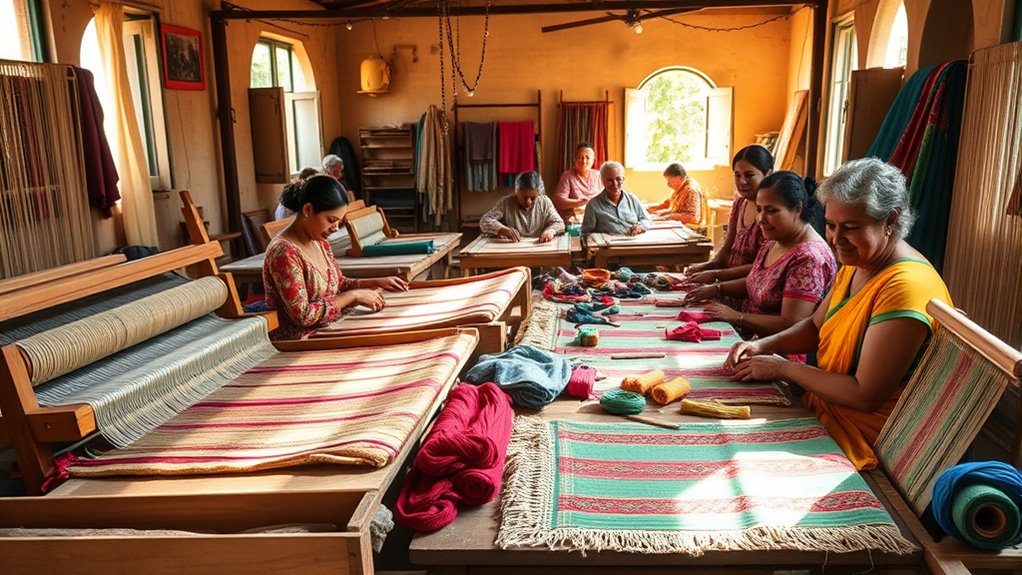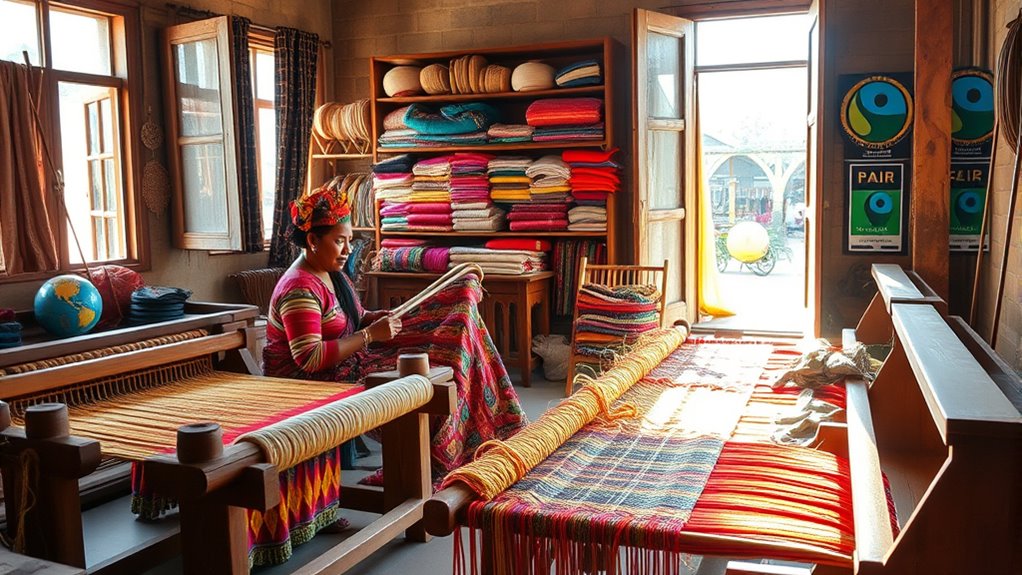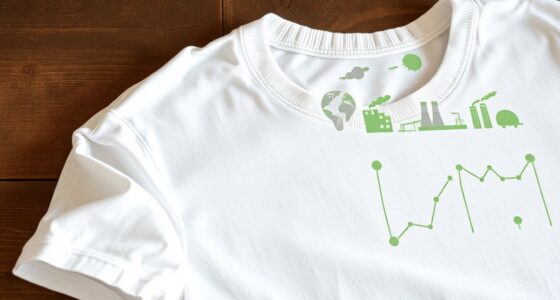Fair trade in textiles works by ensuring that your clothing is made responsibly, with fair wages, safe working conditions, and eco-friendly practices. When you choose certified products, you support ethical treatment of workers and sustainable sourcing, like organic cotton or recycled fibers. Transparent supply chains and regular audits verify these standards. By understanding how fair trade operates, you can make smarter choices that promote a more just and sustainable fashion industry as you explore further.
Key Takeaways
- Fair trade in textiles guarantees workers fair wages, safe working conditions, and respect for their rights through certified standards.
- Sustainable sourcing involves choosing eco-friendly fibers like organic cotton and recycled materials, reducing environmental impact.
- Certification labels such as Fair Trade Certified, GOTS, and Fair Wear Foundation verify compliance with ethical and environmental standards.
- Producers receive fair compensation, which supports community development and promotes ethical farming and manufacturing practices.
- Consumers can support fair trade by choosing certified products, encouraging industry-wide adoption of ethical sourcing and sustainability.

Have you ever wondered if the clothes you wear are made under fair and ethical conditions? It’s a valid concern, especially as awareness around the origins of our clothing grows. When you choose garments that support fair trade in textiles, you’re actively participating in a system that promotes better wages, safer working environments, and sustainable practices. Fair trade aims to empower workers and communities, ensuring they’re treated with dignity and respect. But how does this process work, and what should you look for to make sure your clothing aligns with these values?
One key aspect is sustainable sourcing. Instead of opting for cheap materials that may be produced at the expense of workers or the environment, fair trade advocates for sourcing raw materials responsibly. This involves selecting fibers like organic cotton, hemp, or recycled fabrics that are grown and harvested without harmful chemicals or practices that damage ecosystems. By prioritizing sustainable sourcing, brands reduce their environmental footprint and support farming communities that use eco-friendly methods. This approach not only preserves natural resources but also ensures that workers involved in cultivation receive fair compensation for their efforts. Additionally, implementing vertical storage solutions can help brands manage their supply chains more efficiently, further supporting ethical practices.
Sustainable sourcing involves choosing eco-friendly fibers like organic cotton and recycled fabrics that support fair wages and protect ecosystems.
Another important factor is ethical certification. If you want to be certain that a brand adheres to fair trade principles, look for products bearing recognized ethical certification labels. Certifications such as Fair Trade Certified, GOTS (Global Organic Textile Standard), or Fair Wear Foundation serve as proof that the company complies with strict standards concerning workers’ rights, environmental impact, and fair wages. These certifications require brands to undergo regular audits and maintain transparency about their supply chains, giving you peace of mind that your purchase supports ethical practices.
When you shop consciously, you’re not just buying a piece of clothing—you’re supporting a system that values people and the planet. Brands committed to fair trade often work directly with farmers and artisans, ensuring they receive fair prices and have access to resources that improve their quality of life. They also implement environmentally friendly manufacturing processes, reducing waste and pollution. By choosing products with clear ethical certifications and made from sustainably sourced materials, you help promote a fairer, more sustainable textile industry.
In the end, understanding how fair trade in textiles works empowers you to make informed choices. Your purchasing decisions can drive the industry toward better practices, encouraging more brands to prioritize ethical sourcing and certification. Every garment you buy can be a statement of your values—supporting workers’ rights, protecting the environment, and fostering a more equitable world.
Frequently Asked Questions
How Is Fair Trade Certification Maintained Over Time?
You maintain fair trade certification over time by ensuring supply chain transparency and completing certification renewal processes. Regular audits verify that fair trade standards are upheld, and you must provide documentation of your practices. Staying compliant with evolving criteria and addressing any issues identified during audits helps sustain your certification. By actively engaging in these steps, you demonstrate your commitment to fair trade principles and keep your certification valid.
What Challenges Do Fair Trade Textile Producers Face?
You face challenges like maintaining supply chain transparency and ensuring farmer empowerment amid fluctuating market demands. Managing complex logistics and verifying fair practices can be tough, especially when larger corporations seek cheaper production. Despite these hurdles, your commitment to ethical standards helps protect workers’ rights and supports sustainable growth. Overcoming these obstacles requires vigilance and advocacy, so your efforts continue to foster fair conditions and empower farmers in the textile industry.
How Do Consumers Verify Fair Trade Claims?
You can verify fair trade claims by checking the certification process, which guarantees products meet specific standards. Look for official labels like Fair Trade Certified or FLO. Additionally, increasing consumer awareness helps you spot genuine fair trade textiles. Research brands and their certifications online, and choose products that display verified labels. This way, you actively support ethical practices and make informed choices about the textiles you buy.
Are Fair Trade Textiles More Affordable Than Conventional Ones?
Like a delicate balance, fair trade textiles often aren’t more affordable than conventional ones. You see, the price comparison reflects quality differences — ethically sourced fibers and fair wages add to costs. While fair trade offers better conditions for farmers and workers, it may come with a slightly higher price tag. Still, many find the value in supporting sustainability and social justice, making the extra investment worthwhile.
How Do Fair Trade Practices Impact Local Communities Economically?
Fair trade practices boost local communities economically by promoting economic empowerment and community development. You see, fair trade guarantees fair wages, which increases household income and supports local businesses. This creates a ripple effect, leading to better infrastructure, education, and healthcare. As a result, the community becomes more resilient and self-sufficient, fostering long-term growth. By choosing fair trade textiles, you contribute directly to this positive economic impact on local communities.
Conclusion
By choosing fair trade textiles, you’re supporting ethical practices and empowering producers. Remember, “a rising tide lifts all boats,” meaning your conscious choices can create positive change for everyone involved. When you buy fair trade, you’re not just getting quality fabric—you’re helping build a fairer, more sustainable world. So, make informed decisions and let your actions speak louder than words, because small steps can lead to big impacts.










